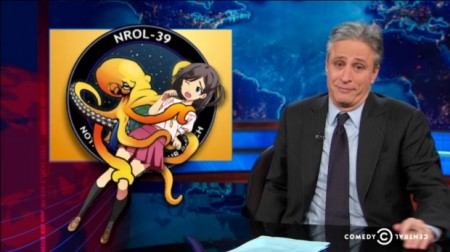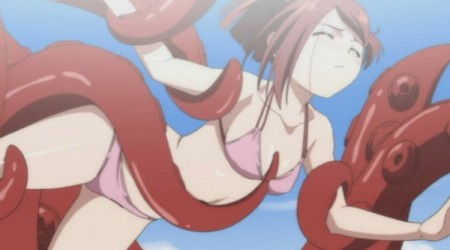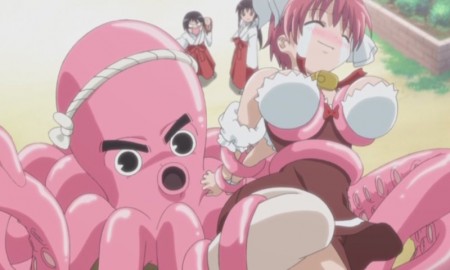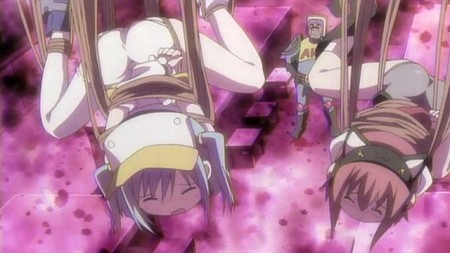Ask John: When did Hentai Become Mainstream?

Question:
Did hentai suddenly become mainstream when I wasn’t looking? First, you hear them casually discuss it in The Internship. Now, you see a giant robot with tentacles in episode 13 of Space Dandy which is clearly modeled after the Chojin in Urotuskidoji. So has what was once a sub-genre of anime gone legit? In the past, it was either the subject of ridicule, or the bane of the existence of regular fans trying to distance themselves from it because it “tainted” the rest of the medium. So is it just because live-action porn has become mainstream in Hollywood (ie Nymphomaniac), that hentai’s simply followed its lead? Or is it simply just a subconscious backlash against moé and dating sim adaptations because they deliberately try to sugar-coat and de-sexualize the relationships of characters while hentai is more honest in its efforts to titillate the viewer?
The influence of erotic anime and notably Toshio Maeda’s lascivious tentacles, which may have been unconsciously inspired by Japanese traditional art including Hokusai’s 1814 illustration “Dream of the Fisherman’s Wife,” has been present and prominent in anime for decades. Even one of the very first professional anime productions from studio Gainax, later acclaimed for productions including Wings of Honneamise, Secret of Blue Water, Gunbuster, and Evangelion, was the adult OVA Beat Shot. The 1985 Dirty Pair: Affair of Nolandia OVA included multiple shots of tentacles threatening nude women. More recently, overt references to lecherous tentacles have appeared in mainstream anime including 2007’s Koharu Biyori OVA series and Moetan television series, 2009’s Kiss x Sis OVAs, 2011’s Dororon Enma-kun Meeramera, Oniichan no Koto Nanka Zenzen Suki Janain Dakara ne, and Rio Rainbowgate TV series, and 2012’s Buso Shinki and Sword Art Online television series, just to name a few examples. As anime has become increasingly provocative in recent years and shows such as School Days (2007) and Yosuga no Sora (2010) have blurred the strict lines between mainstream and adults-only erotic anime, adult sexual references have increasingly crept into mainstream Japanese animation. Actual contemporary adults-only anime, however, doesn’t seem to have appreciably evolved or changed in recent years.
Now that anime has been a prominent sub-culture in America for roughly 15 years, and select representations of anime, including Studio Ghibli movies and Pocket Monster, have become accepted into mainstream American popular culture via homage on The Simpsons, distribution by Disney, and receipt of multiple Academy Awards, American culture has become familiar and comfortable enough with the concept of anime to begin recognizing its fringe elements.An entire generation of American citizens has now reached adolescence having never known of a time when anime wasn’t widely available on American commercial home video. So now that anime itself is no longer some weird, incomprehensible, foreign import but rather a fringe, alternative art form that mainstream Americans acknowledge, American culture is beginning to now acknowledge the existence of fringe aspects of anime. The most obvious and sure sign that American popular culture is beginning to acknowledge and accept the idea that erotic adult anime isn’t a shocking abomination or a destructive, dangerous negative fringe of anime is the December 9, 2013 episode of The Daily Show making a hentai tentacle joke. John Stewart’s Daily Show is a leading vanguard introducing edgy, alternative, provocative ideas into mainstream American popular culture. In effect, when The Daily Show refers to a fringe concept, that concept is already on the cusp of being widely recognized and accepted as an existing principle by mainstream American culture.
A mainstream legitimization of hardcore pornography doesn’t appear to have any relation to the popularization of the concept of erotic anime. The influence of adults-only anime has been increasingly merging into mainstream anime in Japan for years independent from any connection to live-action erotica. If the presence of adult anime references in mainstream anime was a deliberate satirical or critical effort to inject blunt eroticism into moé and galge anime that has sanitized and excluded sexuality, observers could expect that it would actually be moé and galge anime that would receive the most instances of adult reference. But the most obvious specific examples of hentai references appearing in mainstream anime during the past seven or so years have been associated mostly with non-moé and galge genre titles, suggesting that the integration of adult anime influence into mainstream anime is not actually related to or a response to moé or galge anime. In recent years America has not seen a noticeable trend of porno stars transferring into mainstream celebrity status or pornography becoming any more widely embraced by American mainstream culture than it ever has been, so the prominence of hentai references in anime doesn’t seem to be inspired by trends in American pop culture entertainment. The increasing appearance of hentai-style references in mainstream anime – references that have actually been periodically appearing in mainstream anime for the past thirty years – only seem more commonplace now because anime itself is slowly becoming more provocative and graphic. Nudity, panty shots, and bathing scenes have been present in anime since modern anime started, but it wasn’t until Girls Bravo in 2004 that nudity in anime bathing scenes became so graphic and so provocative that such scenes needed to be censored. Especially since 2004 anime has continued to become more explicit, more provocative, and increasingly envelope-pushing, leading to today’s instances of provocative content in mainstream anime such as a nude breast monster in Space Dandy episode 3 and tentacle robot in episode 13, and references to hentai anime appearing in The Daily Show and the line, “What’s hentai? Japanese comic books where the women get penetrated by octopus tentacles,” in the 2013 Vince Vaughn & Owen Wilson comedy film The Internship.
Add a Comment
You must be logged in to post a comment.





Dororon Enma-kun doesn’t count, ‘cus Go Nagai was a perv pushing the envelope before hentai even became a thing.
“In recent years America has not seen a noticeable trend of porno stars transferring into mainstream celebrity status or pornography becoming any more widely embraced by American mainstream culture than it ever has been, ”
Well, yes and no. If you mean that porn stars haven’t been given the same mainstream acting gigs as their non-porn counterparts, that’s true. But they’re slowly making their way into higher-level pop culture. Ron Jeremy was on a friggin’ primetime game show, FFS! And Sasha Grey was in a Soderbergh film, while James Deen acted opposite Lindsay Lohan in an indie pic from Paul Schrader. Also, sexually explicit NC-17 movies are a lot more profitable than they would’ve been in the past here.
“The increasing appearance of hentai-style references in mainstream anime – references that have actually been periodically appearing in mainstream anime for the past thirty years – only seem more commonplace now because anime itself is slowly becoming more provocative and graphic. ”
I think that anime as a whole has become tame in recent years. For example, you can’t get away with topless shots as easily as you would’ve in the past. [Fujiko’s one of the few exceptions, because it’s tied to a long-running series which is well-known for adult situations.] It’s more like the implied sexual content has become more daring than in the past, probably because it’s driving writers bonkers to have to cut-and-paste scripts for high school dating sim situations all day.
“leading to today’s instances of provocative content in mainstream anime such as a nude breast monster in Space Dandy episode 3 and tentacle robot in episode 13,”
Space Dandy can get away with it, because it’s a throwback show, and they know that only a select audience in Japan will be watching it anyway. That is, people who grew up with the sci-fi anime which it references.
Not really sure if this is “main stream” accreditation, but the Season 4 of Archer DVD extras, has a scene with Kreiger and his wife that focuses around a hentai tentacle scene, also somewhat reminiscent of Urotsukidoji….